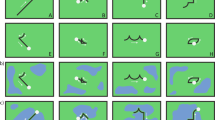Abstract
A 6-month follow-up of an individual reported to engage in validated facilitated communication (FC) is presented. Three main issues are addressed: the current status of the individual's FC use, the effect of food reinforcers on his communicative ability, and a comparison of FC to the Picture Exchange Communication System (PECS). Results indicated that the individual did not engage in any validated FC, that performance was equivalent on food and nonfood trials, and that PECS was the preferred mode of communication, yielding 100% accuracy in a message-passing, object identification task. Implications of these findings are discussed in the context of an individual's right to communicate by objectively validated methods.
Similar content being viewed by others
References
American-Speech-Language-Hearing Association. (1995, March). Position statement facilitated communication.Asha, 37 (Suppl. 14), 22.
Biklen, D. (1993).Communication unbound. New York: Teachers College Press.
Bondy, A. S., & Frost, L. A. (1994). The picture exchange communication system.Focus on Autistic Behavior, 9, 1–19.
Crews, W. D., Sanders, E. C., Hensley, L. G., Johnson, Y. M., Bonaventura, S., Rhodes, R. D., & Garren, M. P. (1995). An evaluation of facilitated communication in a group of nonverbal individuals with mental retardation.Journal of Autism and Developmental Disorders, 25, 205–213.
Foxx, R. (1995). APA passes facilitated communication resolution.Psychology in Mental Retardation and Developmental Disabilities, 20, 18–20.
Frost, L. A., & Bondy, A. S. (1992, August).The picture-exchange communication system (PECS): An interactive communication method for young nonverbal children. Paper presented at the meeting of the International Society for Alternative and Augmentative Communication, Philadelphia, PA.
Green, G. (1994). The quality of the evidence. In H. C. Shane (Ed.),Facilitated communication: The clinical and social phenomena (pp. 157–225). San Diego, CA: Singular.
Jacobson, J. W., & Mulick, J. A. (1995). Ethical dilemmas for practitioners posed by facilitated communication.Psychology in Mental Retardation and Developmental Disabilities, 20, 14–18.
Leiter, R. G. (1982).Leiter International Performance Scale. Los Angeles, CA: Western Psychological Services.
Mayer-Johnson, R. (1981–1992).The picture communication symbols (Vols. I–III). Stillwater, MN: Mayer-Johnson Co.
Office of Mental Retardation and Developmental Disabilities. (1994, February).Advisory to the field regarding facilitated communication. Albany, NY: Author.
Simon, E. W., Toll, D. M., & Whitehair, P. M. (1994). A naturalistic approach to the validation of facilitated communication.Journal of Autism and Developmental Disorders, 24, 647–657.
Vasquez, C. A. (1994). Brief report: A multitask controlled evaluation of facilitated communication.Journal of Autism and Developmental Disorders, 24, 369–379.
Author information
Authors and Affiliations
Additional information
The authors especially thank Student 7, his family, and staff for agreeing to participate in this follow-up study. We also thank Sherrie Schlecker and Carole Nebhut for serving as judges, Joyce Lentz for assistance in literature review and David Rappaport for commenting on this manuscript. This study was supported by Elwyn, Incorporated.
Rights and permissions
About this article
Cite this article
Simon, E.W., Whitehair, P.M. & Toll, D.M. A case study: Follow-up assessment of facilitated communication. J Autism Dev Disord 26, 9–18 (1996). https://doi.org/10.1007/BF02276232
Issue Date:
DOI: https://doi.org/10.1007/BF02276232




